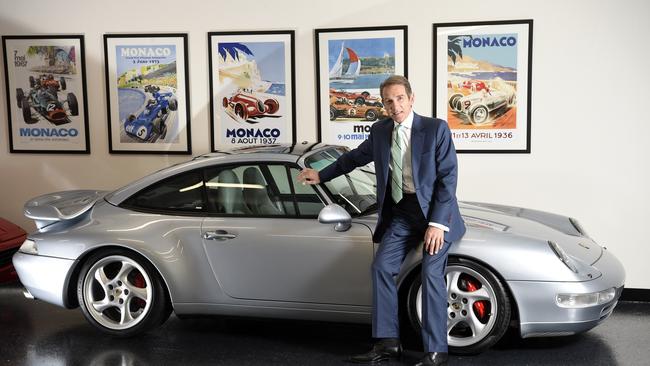‘You can’t drive gold bullion’: why fund manager Paul Huggins has almost 40 Porsches
Far from being a midlife crisis folly, classic Porsche 911 models are making big money and look great in the garage as well.

What’s better than one Porsche 911 – two? Maybe. But If you ask fund manager Paul Huggins, he’ll say 38 and there is always room for more.
That’s how many Mr Huggins – who manages more than $16bn at his firm Hamilton Chase – owns in his classic car collection of more than 100 vehicles.
It’s not a midlife crisis folly. There is serious money to be made in the German car which was launched in 1964.
Take the 964 series for example. The model has delivered average growth of 8 per cent a year since it rolled off production lines three decades ago One driven by rapper-actor Will Smith in 1995’s Bad Boys sold for $US1.3m ($1.88m) at auction last year.
Its former owner and the film’s director, Michael Bay, sold it years earlier for $US60,000, quickly venting his frustration on Instagram after the auction.
Then there is the 993 series, which has grown in value about 7.65 per cent a year since it was launched in 1994.
After the global equity markets delivered dismal returns last year – the ASX 200 lost 5.4 per cent, while the S&P 500 dived 19.4 per cent – alternative investments such as whisky and cars are on the rise.

“When you start comparing the validity of these assets, I do a macro and micro analysis on how they have stood up over a period of time,” Mr Huggins says.
“These cars in question are a limited number. They are not manufacturing any more of these models. They’re still pulling gold out of the ground, they’re still pulling silver out the ground and they’re still printing money.
“So the limited number of supply, the scarcity, is critical.”
Besides, cars are more fun.
“Gold bullion – you can look at it for so long and polish it for so long. But you can’t get in it and take a piece of gold to 100mph, or take it to a wedding, or take your loved one out or enhance the asset,” Mr Huggins says.
“911s when you look back, some of the greatest movie stars Steve McQueen, Robert Redford, were all seen in many movies driving them. Like superheroes, you relate those images in your brain.”
Closer to home, the iconic Porsche model has been driven by the late Kerry Packer, who bought one of the 40 examples of the 933 turbos sold in Australia from 1995 to 1998, keeping it until his death in 2005.
Meanwhile, George Lazenby may have regretted quitting being James Bond after one movie, but at least the actor, a former car salesman in Canberra, had the sense to buy an early 2.2 litre 1970 Porsche 911.
In the past decade, the classic car category is the third highest performing luxury investment category behind whisky and coins, returning 190 per cent, according to Frank Knight’s luxury investment index.
This compares with gold prices rising 13.4 per cent to $US1870.70 an ounce in the past 10 years.

Dietrich Hatlapa, of Historic Automobile Group International, who provides Frank Knight classic car value data, says knowledgeable enthusiasts are the ones most buying, having made a fortune on the stock market or tech.
Mr Hatlapa says those investing in classic cars are somewhat concerned about rising inflation, hence the focus on collectibles. Younger investors are also seeking to gain a foothold in the market but are seeking vehicles that are in “perfect condition with the lowest mileage”.
And this is where Mr Huggins says investors in classic cars need to tread with caution. While enhancements can increase prices, like property investment the vehicles can be more debased than gold, severely denting value.
He says any enhancements he makes to his vehicles can be undone, and the car is sold in its original condition, unlike some other buyers who make irreversible changes like cutting into bodywork and overcapitalising on their investment.
“You have a lot of control over the enhancement of the asset – you and I don’t have the ability to change the share price of Apple today. You don’t have the same ability in the stock market,” Mr Huggins says.
“I will spend 20 per cent (of the car’s value) to enhance that vehicle. That’s the discipline. One of my mates bought a $50,000 hot rod and then spent $300,000 on enhancements, and if they’re lucky, they’ll sell it for $100,000.

“Then what I can do can be unplugged, so if you ever sell to a purist later on, a $250,000 car without any enhancements in five to eight years’ time is worth $400,000.”
While Mr Huggins employs the same investment principles in classic cars that he uses in his professional life, it is more of a passion than a business.
“When you start looking at defensive assets because of low interest rates and bonds, treasuries, and term deposits and cash, have been quite low,” he says.
“Cars sort of fell into my life through passion. I mean, we’re not recommending cars in managed funds – we’re not at that point and I don’t know if we’ll go down that track. This is purely an observation that I’ve made and applied with my own money.”
That said, he has been approached by about 100 people seeking his help to buy Porsche 911s. A television production company has also sounded out his interest in filming a series about how he sources classic vehicles.
“If someone got $1m or $100m and said to me off the cuff, ‘Paul I don’t want any personal advice but I’m in the cars, what sort of money should I be allocating to a classic car collection?’ I would say in my experience in 35 years that would be 5 per cent to possibly 10 per cent,” he says.
“That’s how strongly I feel about that asset class. It’s not selling you BHP shares and going out and buying classic cars – we don’t advocate that at all.
“But when you blend a particular asset, like coins, whisky, classic cars, precious metals into that defensive asset or a portfolio it works extremely well. But you have got to keep it in perspective.
“I mean, I go to functions and you talk about investment banking and the first thing they’ll do as an icebreaker is talk about which 911 should I buy?
“I ask ‘well how many cars have you owned?’ and they’ll say ‘I haven’t owned any’. Well just take it easy; you need a bit of a check-up from neck up, as my grandfather used to say.”




To join the conversation, please log in. Don't have an account? Register
Join the conversation, you are commenting as Logout